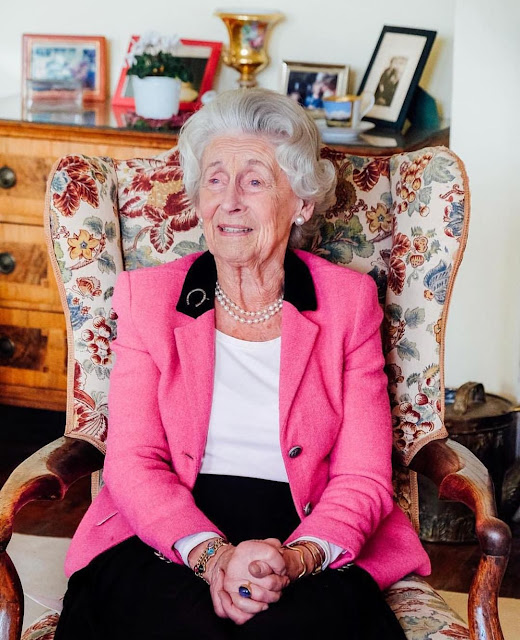 |
| Duchess Marie-Alix of Schleswig-Holstein on the occasion of her 95th birthday. Photo courtesy of Fürst Alexander zu Schaumburg-Lippe / Stiftung Louisenlund. |
On Monday, 1 November 2021, Dowager Duchess Marie-Alix of Schleswig-Holstein died peacefully at her home of Gut Bienebek in Holstein. She was ninety-eight years-old. The four children of the duchess were by her side when she died in her sleep; after her passing, the family released a brief statement: "In deep sorrow and full of love we say goodbye to our mother, grandmother and great-grandmother and look back on her eventful and fulfilled life with respect and immense gratitude."
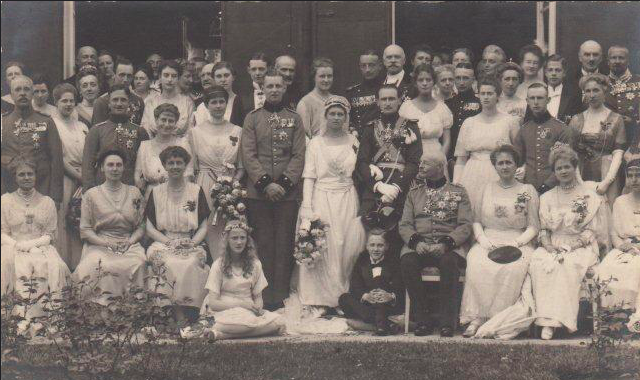 |
| The wedding of Prince Stephan zu Schaumburg-Lippe and Duchess Ingeborg of Oldenburg, 1921. |
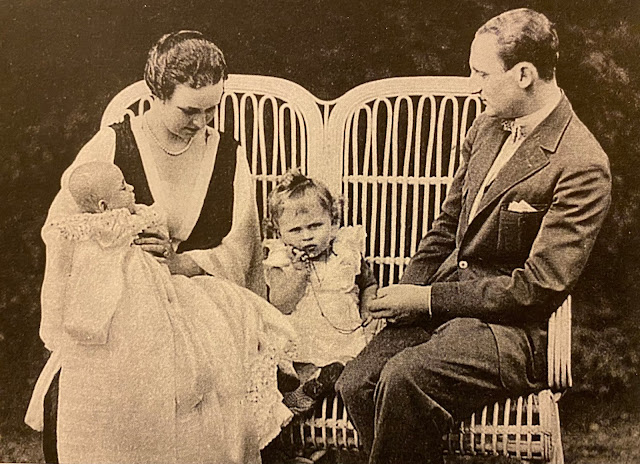 |
| Prince Stephan and Princess Ingeborg with Princess Marie-Alix and infant Prince Georg-Moritz. Photo (c) David McIntosh. |
Born on 2 April 1923 at Bückeburg, Princess Marie-Alix of Schaumburg-Lippe was the first child and only daughter of Prince Stephan of Schaumburg-Lippe (1891-1965) and Duchess Ingeborg of Oldenburg (1901-1996), who married in 1921. Marie-Alix was followed by a younger brother, Prince Georg-Moritz of Schaumburg-Lippe (1924-1970), who sadly was killed in a automobile accident at the age of forty-six. As her father Stephan was a German diplomat, Marie-Alix lived with her family in Sofia, Bulgaria; Rome, Italy; Rio de Janeiro, Brazil; Buenos Aires, Argentina; and Santiago, Chile. After the end of World War II, Marie-Alix spent time with her maternal Oldenburg relations in Lensahn, Ostholstein.
 |
| Fürst Georg zu Schaumburg-Lippe. |
 |
| Fürstin Marie zu Schaumburg-Lippe. |
 |
| Grand Duke Friedrich August II of Oldenburg. |
 |
| Grand Duchess Elisabeth of Oldenburg. |
The paternal grandparents of Marie-Alix were Fürst Georg of Schaumburg-Lippe (1846-1911) and his wife Princess Marie of Saxe-Altenburg (1864-1918). Her maternal grandparents were Grand Duke Friedrich August II of Oldenburg (1851-1932) and his second wife Duchess Elisabeth of Mecklenburg-Schwerin (1869-1955). Marie-Alix was a first cousin of Duke Anton-Günther of Oldenburg, Fürstin Eilika of Leiningen, Fürst Wittekind of Waldeck and Pyrmont, Fürstin Guda of Wied, and Fürst Philipp-Ernst of Schaumburg-Lippe.
 |
| Duke Peter of Schleswig-Holstein. Photo (c) David McIntosh. |
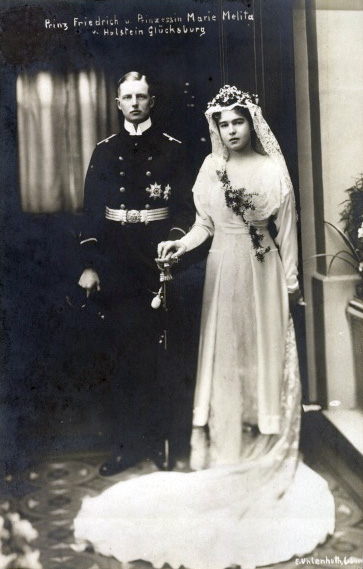 |
| Prince Friedrich Ferdinand zu Schaumburg-Lippe and Princess Marie Melita zu Hohenlohe-Langenburg on their wedding day. |
 |
| Left to right: Duke Friedrich Ferdinand, Prince Peter, and Princess Marie-Alix. Photo (c) David McIntosh. |
On 9 October 1947 at Glücksburg, Princess Marie-Alix married Prince Friedrich Ernst Peter of Schleswig-Holstein (1922-1980). Peter was the third child and son of Duke Friedrich Ferdinand of Schleswig-Holstein (1891-1965) and his wife Princess Marie Melita of Hohenlohe-Langenburg (1899-1967). Peter and Marie-Alix were third cousins; they were both descendants of Fürst Georg of Schaumburg-Lippe (1784-1860) and his wife Princess Ida of Waldeck and Pyrmont (1796-1869). Peter and Marie-Alix made their home at Gut Bienebek, Rendsburg-Eckernförde. Aged fifty-seven, Marie-Alix became a widow in 1980 when her husband Peter died at the rather young age of fifty-eight. The duchess remained devoted to Schleswig-Holstein from her marriage until her last breath.
 |
| Left to right: Princess Marita, Prince Alexander, Duke Christoph, and Princess Ingeborg. Photo (c) David McIntosh. |
 |
| Princess Barbara with her mother-in-law Duchess Marie-Alix at the wedding of Hereditary Prince Bernhard of Baden, 2001. Photo (c) Seeger-Presse. |
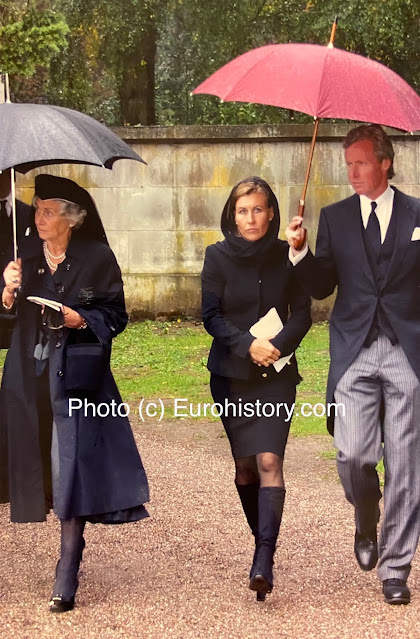 |
| Duchess Marie-Alix together with her son Duke Christoph and daughter-in-law Duchess Elisabeth attend the funeral of Fürst Philipp-Ernst zu Schaumburg-Lippe, 2003. |
Duke Peter and Duchess Marie-Alix of Schleswig-Holstein had four children, two girls and two boys: Princess Marita (b.1948; married in 1975 to Baron Wilfried von Plotho), Duke Christoph (b.1949; married in 1981 to Princess Elisabeth zur Lippe-Weissenfeld), Prince Alexander (b.1953; married in 1994 to Barbara Beata Fertsch), and Princess Ingeborg (b.1956; married in 1991 to Nikolaus Broschek).
 |
| Birthday cheers! Duchess Marie-Alix celebrates her 95th birthday surrounded by students of Louisenlund while her daughter Princess Ingeborg happily looks at her much loved mother. Photo (c) Stiftung Louisenlund. |
Duchess Marie-Alix of Schleswig-Holstein was a co-founder of the Louisenlund Foundation in 1949. This institution was envisioned by her father-in-law Duke Friedrich Ferdinand, and its mission was made a reality by continued support from her husband Duke Peter, her son Duke Christoph, and her daughter Princess Ingeborg. According to its website, Louisenlund "
has created a school system with learning and teaching methods which prepare students for the future. To be equipped for the future students must develop social awareness and a strong personality. Since the very beginning, the private foundation, Louisenlund has strived to achieve a holistic education for its students. Moreover, Louisenlund is embedded in a network of international contacts and partner schools. Around 440 students benefit from an education in a global environment whilst enjoying, at the same time the familiar atmosphere of the campus." Princess Ingeborg, the youngest child of the duchess, is the current chairperson of the foundation's Board of Governors as well as of the Board of Trustees. The original uniform of Louisenlund students was created from a blue sweater out of Duke Friedrich Ferdinand's wardrobe and a red sock from his daughter-in-law Duchess Marie-Alix's closet which served as the collar.
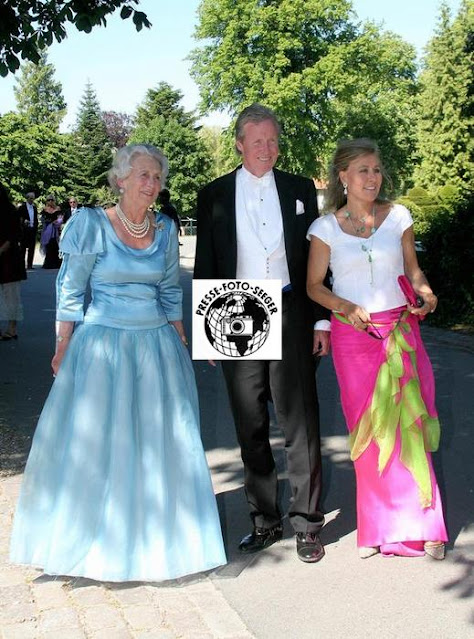 |
Duchess Marie-Alix, her son Duke Christoph, and her daugher-in-law Duchess Elisabeth at the wedding of Prince Philipp of Hesse, 2006. Photo (c) Seeger-Presse / Albert Nieboer. |
Duchess Marie-Alix of Schleswig-Holstein is survived by her four children, by her nine grandchildren, and by her (at least) five great-grandchildren.
 |
| The duchess in 2004. |
May Marie-Alix Rest in Peace. Sources:
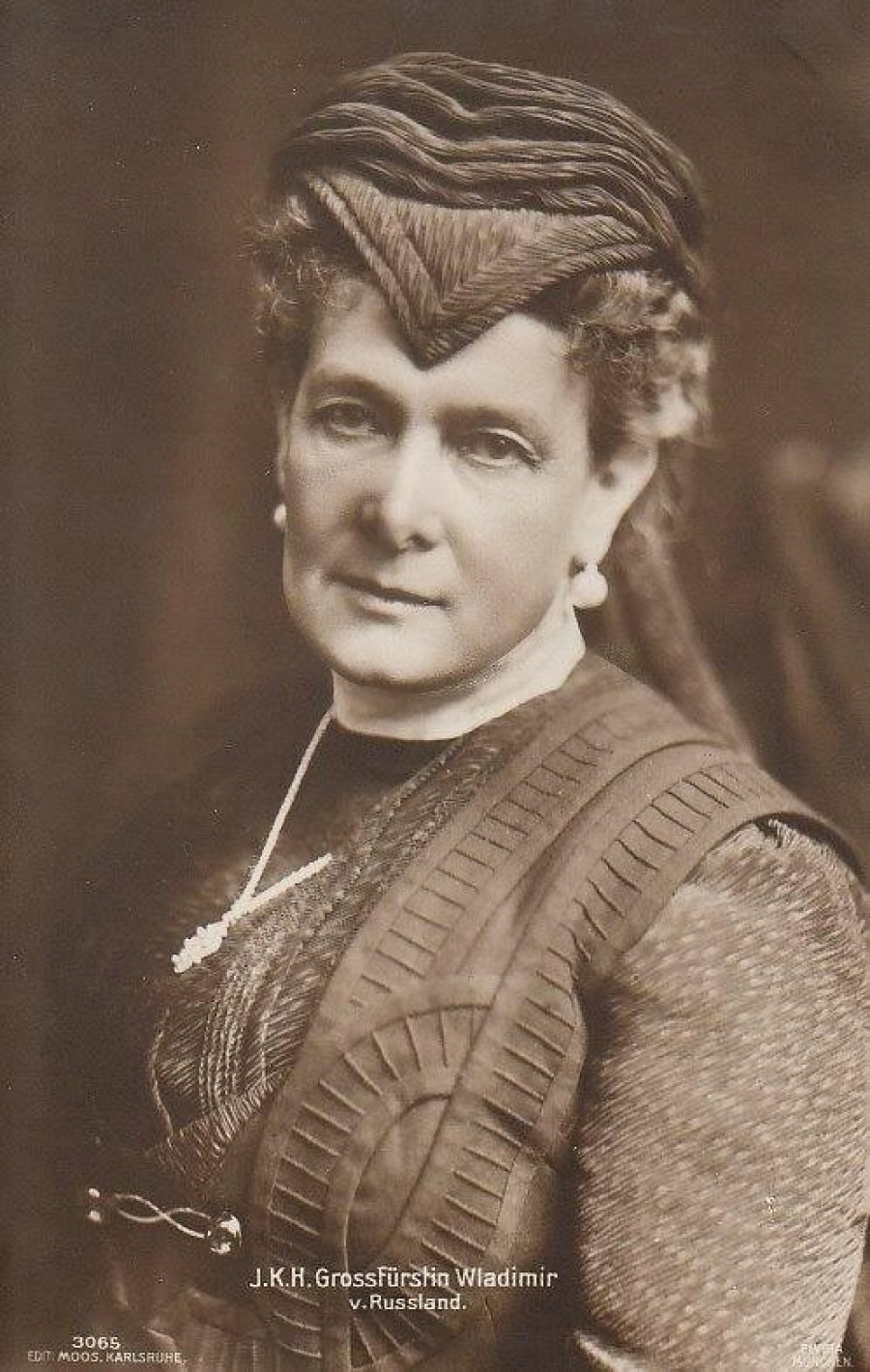















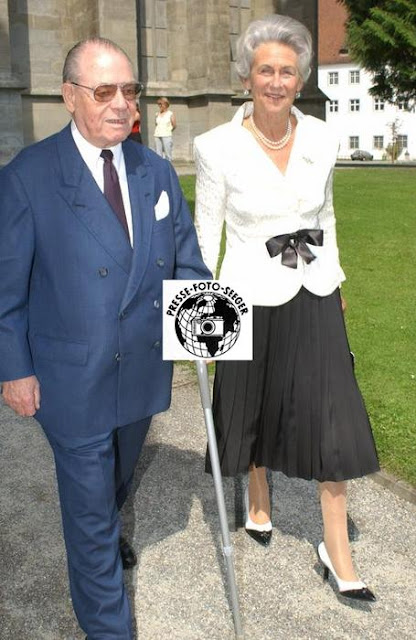

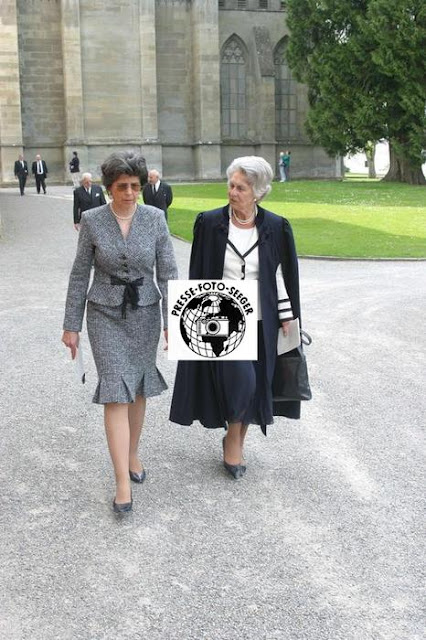


No comments:
Post a Comment